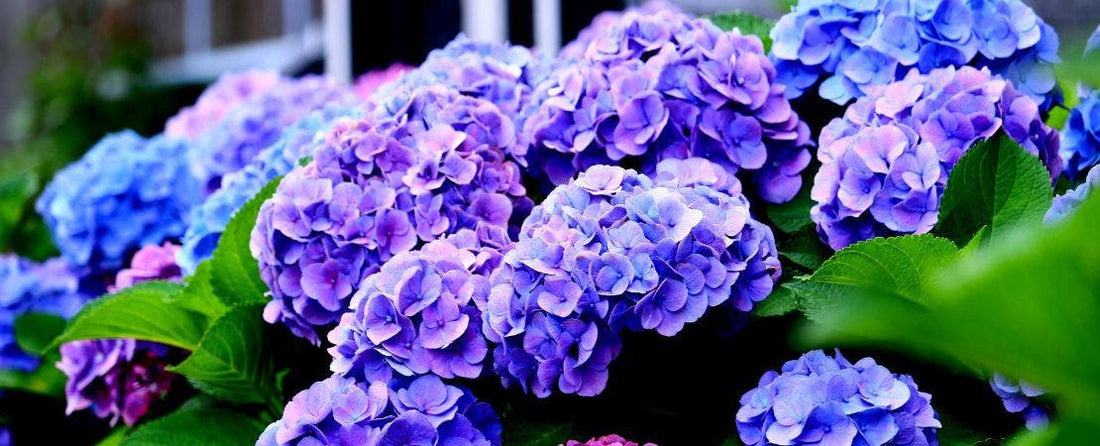Growing Hydrangeas: Which Type to Plant in Your Zone?

Choosing the Best Hydrangea for Your Growing Zone
Hydrangeas are treasured for their vibrant blooms and lush foliage, adding an elegant touch of drama to your garden. But with so many varieties available, choosing the right one for your climate can be a challenge. This guide will explore the most popular types and match them to their ideal hydrangea hardiness zones, ensuring you find the right type of your garden.
Hydrangea macrophylla
It's the quintessential hydrangea flower form, boasting large, mop-head blooms in shades of blue, pink, purple, and white. Bigleaf hydrangea thrives in growing zones 5-9, preferring morning sun and afternoon shade.
What hydrangea colors are you looking for? Mophead flowers come in solid deep red, variegated red, pink, purple, blue, white, and ruby
NOTE: Lacecap is a style of flower not a type of hydrangea. The lacecap flower style occurs in several different species. Lacecap hydrangeas have flat flower heads while mophead blooms are rounded.
Hydrangea paniculata
These are hardy hydrangeas that grow throughout most of the country from Hardiness Zones 3-9, depending on the variety. They have the best heat and cold tolerance of all hydrangeas and grow successfully in full sun and partial shade. Long, conical flower clusters bloom from summer to fall. Typically white, some varieties like Limelight' Hydrangea boast lime-green blooms that mature to creamy white. In zones with cooler temperatures, most panicle hydrangeas will turn pink or blush colored--sometimes even red--as they mature.
Try growing panicle hydrangeas in containers. While the rule of thumb for perennials in containers to survive winter is to choose plants that are two zones hardier than yours. You can prune them in spring or fall since they bloom on new wood.
Hydrangea arborescens
This North American native bears large, snowball-like clusters of pure white blooms. Smooth hydrangea flowers bloom earlier than bigleaf and most have mophead-style blooms.
Smooth hydrangeas thrive in hardiness zones 3/4-9 superstar that tolerates full sun to part shade. Like panicle hydrangeas, smooth hydrangeas bloom on new wood, so prune when shrubs are dormant.
Because smooth hydrangeas grow buds in spring, they are ideal for colder climates since the tender new buds won’t be harmed by winter’s cold.
Popular hydrangea plants in this type include Annabelle' hydrangea, and the Invincibelle® and Incrediball® series.
Hydrangea quercifolia
Unique within the hydrangea shrub family and easy to identify because of their unique oak-like leaves and showy blooms, these white cone-shaped flowers take on pink or red tones in fall. The Gatsby series of oakleaf hydrangeas have lacecap blooms.
Oakleaf hydrangea flowers are often the first to bloom in early summer. While they don’t typically rebloom, their blooms last for months and dry to nearly perfect replicas of their summer selves. This type and panicle hydrangeas have exceptional winter interest (the best in the genera) and provide protection for wildlife. Oakleaf types develop more slowly and can live for decades.
Oakleaf hydrangeas are heat-tolerant and thrive in growing zones 5-9, tolerating full sun to part shade.
Hydrangea serrata
Mountain hydrangeas are typically smaller than other hydrangea types, which makes them ideal for growing in small space gardens and in containers and decorative pots on the patio. The deciduous shrubs are native to Japan. Because hydrangeas prefer moist soil, a layer of mulch can be added in dry climates to help retain moisture. They may require additional water in the hot and dry days of late summer.
Blooming from midsummer to early fall, mountain hydrangeas have serrate leaves that turn deep red in fall. They are cold-hardy and ideal for gardeners who have cold winters. The hydrangea hardiness zone recommendation for mountain hydrangeas goes as far as Zone 4 for select varieties.
Best Hydrangeas by USDA Hardiness Zone
Now that you're familiar with the types of hydrangeas, let's find the perfect match for your Zone:
- Hydrangea Growing Zones 3-4: Panicle and Smooth hydrangeas reign supreme, braving the cold winters with grace.
- Hydrangea Growing Zones 5-7: Bigleaf, Panicle, Smooth, and Oakleaf hydrangeas offer a dazzling selection.
- Hydrangea Growing Zones 8-9: All the varieties flourish.
Remember, even within Zones, microclimates and individual garden conditions can influence success. Consider factors like sun exposure, soil drainage, and moisture when choosing your hydrangea. Don't forget, these beauties love acidic soil for those stunning blue blooms! With a little planning and a soil test, your garden will be bursting with hydrangea beauty in no time.







